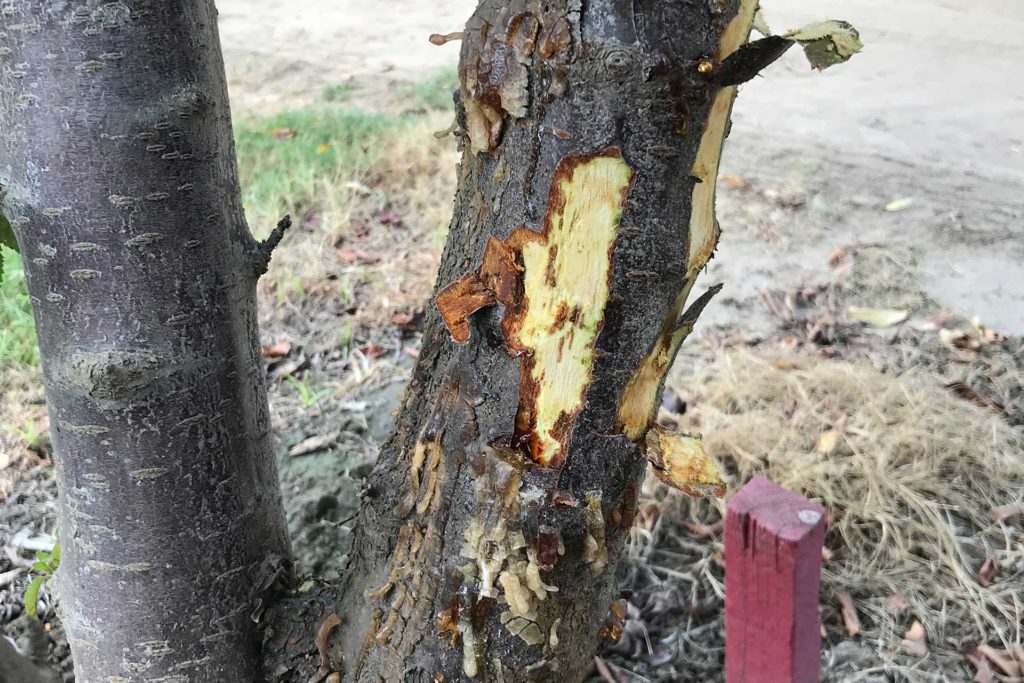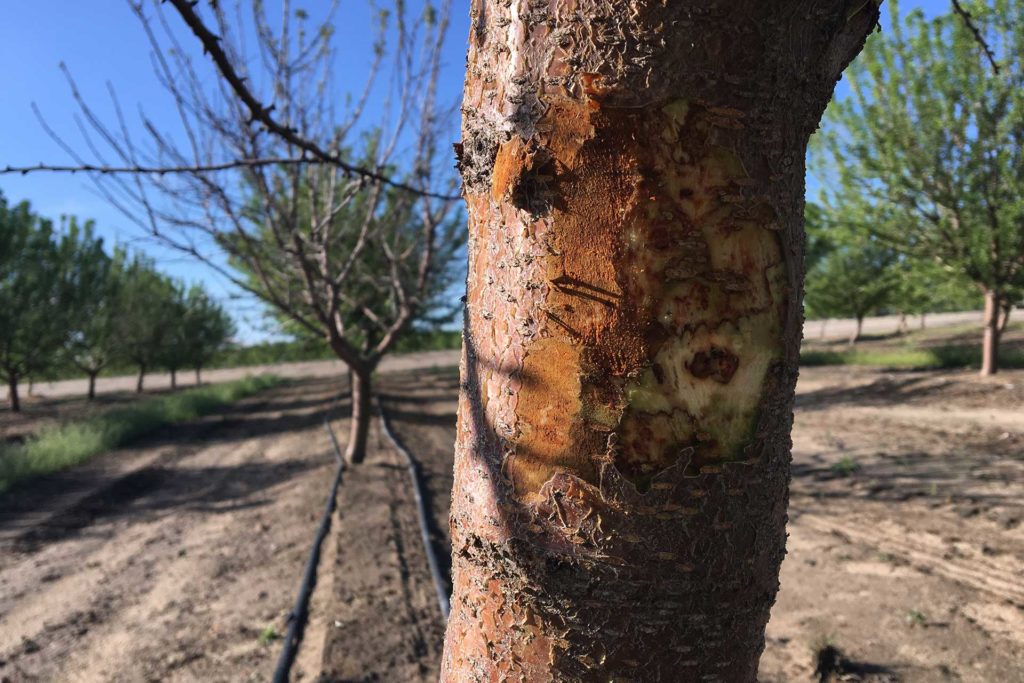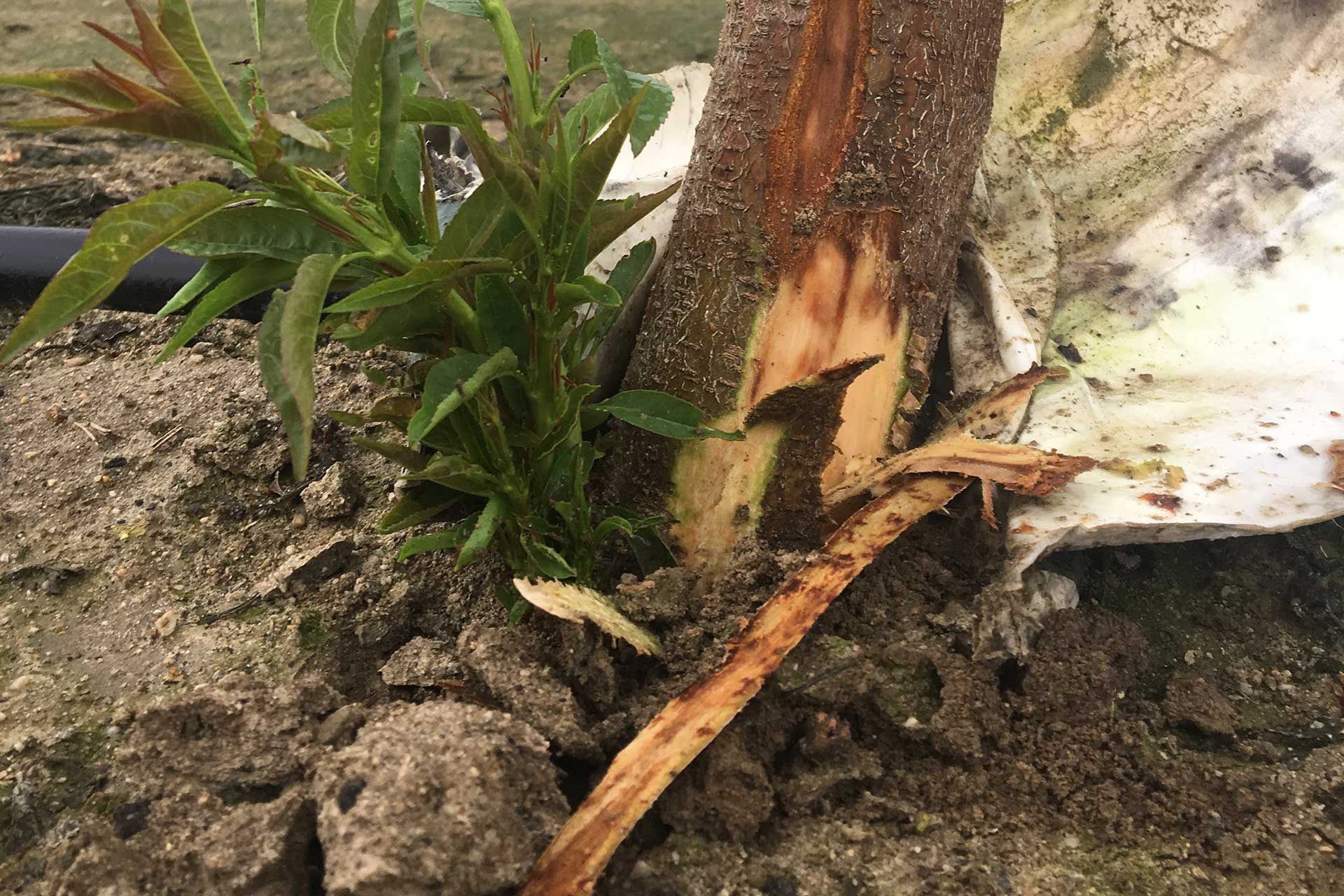Bacterial blast and bacterial canker are caused by the bacterium Pseudomonas syringae pv. syringae (Pss). Both diseases are a tough problem to deal with in almond and stone fruit orchards. Bacterial diseases are more common in cold and humid regions causing significant damage to orchard trees. However, we can still see both diseases causing significant losses under certain conditions here in California. As detailed below, it doesn’t require existing wounds for infection (but they certainly can increase a tree’s vulnerability), it is exacerbated by but doesn’t need plant stress to infect, and it currently has no effective chemical control options.
P. syringae pv. syringae is an epiphytic bacterium which resides on plant surfaces. It’s safe to assume it’s in many orchards in California, however it will not invade the plant until conditions are conducive to infection: wet weather accompanied by freezing temperatures which can damage plant tissue. Even the mild frosts we typically experience in California can facilitate the movement of the bacteria through the bark. This invasion can cause bacterial canker infections as well as bacterial blast, which can move into twigs in fruit trees progressing sometimes to canker development (Kennelly et al., 2007). Late season pruning wounds can be entry points for infection, and while leaf scars have been implicated in the past, later work has not shown any connection (Sayler and Kirkpatrick, 2003). P. syringae can also invade leaves through stomata (Kahlon, 2016).
Symptoms and Causes of Blast and Canker
Symptoms of bacterial blast are shriveled up, ‘fried’ looking blossoms, often on twigs that have died back. In more extreme cases in California, Pss can invade buds through the bud scale scar, killing buds before they have the chance to open. Some UC personnel regard the two as different diseases, though they are caused by the same pathogen. Conditions leading to bacterial blast are less understood than bacterial canker. Cool, rainy conditions can predispose trees to blast, it tends to be more severe in the lower canopy and in cold spots in the orchard.
Bacterial canker infections show up as amber-colored gumballs on the trunk or scaffolds of trees that end at the graft union. If you cut away at the bark and smell the canker, it gives off a sour and fermented scent. The margin of the canker is not solid or continuous, such as on phytophthora for instance, but shows as streaks and flecks. P. syringae pv. syrnigae causes damage to plant tissue by producing a toxin called syringomycin. This phytotoxin kills plant cells by disrupting cellular membranes and leads to the presence of the cankers we observe in the field.

Stress is a Factor
Bacterial canker infections are more common in stressed orchards. We have seen them most commonly in young Prunus species orchards (5th leaf or younger) on peach x almond hybrid rootstocks in sandy soils, with no fumigation prior to replanting. These sites often have high ring nematode populations. Plant nutritional status may play a role as well, as detailed later. These conditions are all stressful to replanted Prunus species, which makes them more susceptible to infection. It’s important to note that while ring nematode feeding increases the susceptibility of Prunus species to bacterial canker, the feeding damage itself does not lead to infection, as Pss only affects above-ground portions of the plant. Bacterial canker doesn’t need these conditions to attack trees: one recent farm call revealed bacterial canker in a heavier textured orchard planted into former rangeland.
There has been some work done looking at the efficacy of copper as a bactericide against both bacterial blast and bacterial canker, however studies have shown that it often doesn’t work, likely due to the fact that there is some degree of copper resistance or tolerance in many Pss populations, and other work has shown that treatments that improve the condition of the tree is more effective at reducing canker disease severity. Sayler and Kirkpatrick (2003) examined copper sprays, NPK and copper+NPK in young French prune trees and found that copper sprays did not reduce damage severity compared to the control, while NPK and copper+NPK did. Copper sprays reduced disease incidence, however. There has been other research showing that Pss populations found in California are mostly resistant to copper bactericides, so we do not recommend relying on sprays to control either disease.
Nutrient Status and Disease
Research on the connection between plant nutrient status and bacterial canker has also been mixed. The previous study mentioned showed some positive effect due to added nutrients. In other work, Roger Duncan and Bruce Kirkpatrick sprayed third-leaf peach trees with 100 pounds of low-biuret urea in 100 gallons of water per acre. The peach trees were growing either in fumigated or unfumigated ground and were artificially infected with Pss. They found that trees that were grown in fumigated ground had smaller cankers than those grown in unfumigated ground. Urea sprays had no effect on trees in treated soil. In addition, of the trees grown in untreated soil, urea sprays significantly reduced canker sizes compared to the control, and the cankers in these trees were no larger than trees grown in fumigated soil. However, it should be noted in a paired trial performed at Kearney REC, there was no effect due to urea sprays. (Cao et al., 2005). It seems that urea sprays work by increasing the nitrogen content in the trees, which suppresses Pss’ production of syringomycin, which is what kills plant cells and causes cankers.
In the absence of the major predisposing factors described earlier, Cao et al. (2011) examined inducing nutrient deficiencies in potted peach seedlings before purposefully infecting them with Pss, as well as re-examining the role of freeze-thaw cycles in Pss infections. They confirmed the importance of freeze-thaw cycles in lesion size development, but the nutrition study connected only phosphorus to lesion size: phosphorus deficiency reduced bacterial canker lesion size. The researchers were so surprised they performed another study where they induced nitrogen deficiency and tried infecting leaf scars: they found that more leaf scars were infected in plants with nitrogen deficiency, but the lesions developed were very small and there was no difference in lesion size.

Management Strategies
Rootstock selection is also important when trying to manage bacterial canker. Peach almond hybrids and Mariana 2624 are the most vulnerable, especially when put in sandy ground, which has been backed up by farm advisor observations on field calls. Viking, Lovell, and Guardian are the most tolerant.
So, what’s the bottom line? Remember that stress plays a major role in predisposing Prunus trees to this disease. If you’re planting an orchard in sandy soils with a history of bacterial canker or ring nematode, set your orchard up for success by fumigating (which also reduces the chances of getting Prunus Replant Disease) and selecting tolerant rootstocks. This is the most important thing you can do. Keep your trees vigorous and in good health, and only think of post-plant treatments as a last resort. Work is underway to evaluate the efficacy of Velum and Movento as post plant nematicides, however whether they reduce tree stress enough to reduce bacterial canker would need to be evaluated separately.
In the spring of 2019 there were localized areas, including Madera county, where there were a large number of orchards that were hit with flower blast. Isolations done by Florent Trouillas’s lab pulled both Pss and Botrytis cinerea from blasted blossoms, and he concluded that the spring’s cool, extremely wet conditions led to a disease complex. While fungicides are absolutely not a control option for Pss, it’s important in unusually cool, wet springs to select bloom sprays that will target B. cinerea as well as the more typical bloom-time pathogens. Please consult the fungicide efficacy tables published on the UC IPM website for the appropriate fungicides to target B. cinerea.











